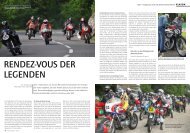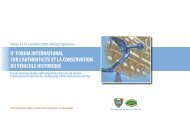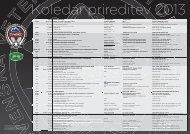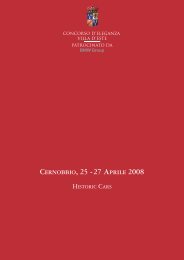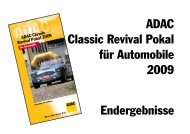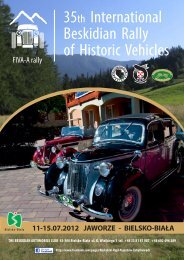FORUM INTERNATIONAL SUR L'AUTHENTICITE DU VEHICULE HISTORIQUE ...
FORUM INTERNATIONAL SUR L'AUTHENTICITE DU VEHICULE HISTORIQUE ...
FORUM INTERNATIONAL SUR L'AUTHENTICITE DU VEHICULE HISTORIQUE ...
Create successful ePaper yourself
Turn your PDF publications into a flip-book with our unique Google optimized e-Paper software.
.6<br />
160<br />
carrosserie automobile, Impresa 1997, 226) une<br />
probable solution de compromis (par exemple, un<br />
protection de très brève durée, inférieure à 15 ans).<br />
L’augure s’est concrétisé par la Directive 98/71/CEE<br />
du 13 octobre 1998 sur la protection juridique des<br />
dessins et des modèles, qui n’a pas du tout résolu le<br />
conflit entre certains états membres, mais l’a tout<br />
simplement laissé de côté, en renvoyant à plus tard la<br />
solution. En effet il “Considerando n. 19” de la<br />
directive a disposé un moratoire de trois ans, à<br />
compter de la date d’entrée en vigueur de la directive<br />
avant d’analyser les “conséquences mercantiles des<br />
actuelles dispositions communautaires”, avec<br />
réserve d’intervenir d’ici l’année suivante pour<br />
d’éventuelles modifications, tandis que l’article 14, en<br />
relation aux modèles et des dessins relatifs à un<br />
“composant utilisé pour la réparation d’un produit<br />
complexe afin d’en rétablir l’aspect original”, établit –<br />
en phase transitoire- et jusqu’au moment où la<br />
directive n. 98/71/CE ne sera pas modifiée – que les<br />
états membres :<br />
a) maintiennent en vigueur leurs actuelles<br />
dispositions juridiques concernant l’usage du dessin<br />
ou modèle protégé;<br />
b) introduisent des modifications à leurs actuelles<br />
dispositions juridiques, seulement dans l’objectif de<br />
libéraliser le marché de ces “composants”.<br />
La directive a été reçue en Italie par le d.l. 2 février<br />
2001 n. 95 qui a modifié le r.d. 25 août 1940 n. 1411 (l.<br />
mod), en introduisant pour les “modèles<br />
ornementaux” (qui maintenant s’appellent<br />
simplement “modèles”) le régime de<br />
l’enregistrement et non plus du brevet, uniquement<br />
si “ils ont neufs et ont un caractère individuel”.<br />
Significatif du point de vue pratique est l’art.9, alinéa<br />
2, 1. mod (nouveau texte) sur la durée de la<br />
protection: cinq ans, prorogeables pendant une ou<br />
originario”, stabilisce – in via transitoria e fino al<br />
momento in cui la Direttiva n.98/71/CEE non sarà<br />
modificata – che gli Stati membri:<br />
a) mantengano in vigore le loro attuali disposizioni<br />
giuridiche riguardanti l’uso del disegno o modello<br />
protetto;<br />
b) introducano modifiche alle loro attuali disposizioni<br />
giuridiche solo con l’obiettivo di liberalizzare il<br />
mercato di tali “componenti”.<br />
La Direttiva è stata recepita in Italia con d.lgs. 2<br />
febbraio 2001 n. 95 che ha modificato il r.d. 25 agosto<br />
1940 n.1411 (l. mod.), introducendo per i “modelli<br />
ornamentali” (che ora si chiamano semplicemente<br />
“modelli”) il regime della registrazione e non più del<br />
brevetto, solo se “siano nuovi e abbiano carattere<br />
individuale”.<br />
Rilevante dal punto di vista pratico è l’art. 9, comma<br />
2, l. mod (nuovo testo) sulla durata della protezione:<br />
cinque anni, prorogabili per uno o più periodi fino ad<br />
un massimo di venticinque anni, a decorrere dalla<br />
data di presentazione della domanda.<br />
Ancora più rilevanti le norme transitorie contenute<br />
negli artt. 24-27, uno dei quali (art.27) riservato in<br />
modo inequivocabile alla materia del body panel.<br />
Nel contempo, come per la materia dei marchi, in<br />
sede europea è stato emanato il Regolamento CEE n.<br />
6/2002 del 12 dicembre 2001 su “disegni e modelli<br />
comunitari”, nel quale il fenomeno body panel trova<br />
una sua regolamentazione con l’art. 4, comma 2, e<br />
l’art. 8, comma 2, in armonia con i “considerando”<br />
n.12, 13, 14.<br />
12) L’atteggiamento della dottrina<br />
All’inizio del 2000, nonostante le novità sopra citate,<br />
il dibattito sulla brevettabilità dei pezzi di ricambio di<br />
carrozzeria appare in Italia ben lontano da una<br />
conclusione univoca.<br />
SAUVEGARDE JURIDIQUE DE L’AUTENTICITE<br />
SALVAGUARDIA GIURIDICA DELL’AUTENTICITÀ<br />
LEGAL SAFEGUARDS OF AUTHENTICITY<br />
Mario Barbuto, IT - Président du Tribunal de Turin<br />
year for any modifications, while art. 14, in relation to<br />
models and designs regarding a “component utilised<br />
for the repair of a complex product so as to restore<br />
its original appearance”, establishes – temporarily<br />
and until the Directive no. 98/71/EC is modified – that<br />
the member States:<br />
a) maintain the current legal dispositions in force<br />
regarding the use of protected models or designs;<br />
b) introduce modifications to their current legal<br />
dispositions with the sole aim of liberalising the<br />
market for such “components”.<br />
The Directive was assimilated in Italy by the<br />
legislative decree 2 February 2001, no. 95 which<br />
modified the royal decree 25 August 1940 no. 1411<br />
(model law), introducing for “ornamental models”<br />
(now called simply “models”) the system of<br />
registration and no longer the patent, only if “they<br />
are new and have an individual character”.<br />
From a practical point of view, art. 9, sub-paragraph<br />
2 of the model law (new text) is relevant as regards<br />
the duration of protection: five years, which may be<br />
extended for one or more periods up to a maximum<br />
of twenty-five years, starting from the date of filing<br />
the application. Even more relevant are the<br />
temporary regulations contained in articles 24-27,<br />
one of which (art. 27) unquestionably referring to the<br />
body panel issue.<br />
In the meantime, as with the question of trademarks,<br />
the EC Regulation no. 6/2002 dated 12 December<br />
2001 was emanated at a European level on “<br />
community designs and models”, and in which the<br />
body panel phenomenon is regulated by art. 4, subparagraph<br />
2 and art. 8 sub-paragraph 2, in harmony<br />
with the “Recitals” no. s 12,13 and 14.



